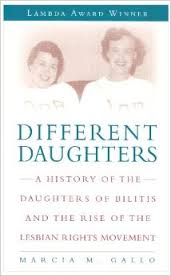 Different Daughters: A History of the Daughters of Bilitis and the Rise of the Lesbian Rights Movement
Different Daughters: A History of the Daughters of Bilitis and the Rise of the Lesbian Rights Movement
by Marcia Gallo
Carroll & Graff. 274 pages, $25.95
IN 1955, Rose Bamberger, a Filipina lesbian, brought together four couples to form a “secret society of lesbians” in San Francisco. She wanted to be able to dance, drink, and socialize without the fear of harassment or arrest that homosexuals risked at the bars. At the first meeting someone suggested that the group be called the Daughters of Bilitis (DOB) (bil-EE-tis). An English translation of Pierre Louÿs’ 1894 book of poems, Les chansons de Bilitis, had been published that year, and it seemed an obscure, even highbrow, name for a subversive organization. An equally arcane name had been selected in 1950 for a “homophile” group that had been founded in Los Angeles: the Mattachine Society. Its founder, Harry Hay, was a member of the Communist Party and envisioned the Mattachine as a radical secret society for homosexual men. However, the conservative climate of Cold War America and Red-baiting by the L.A. press caused Mattachine to marginalize Hay by 1953.






